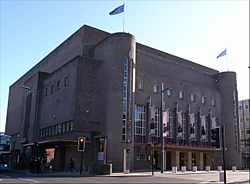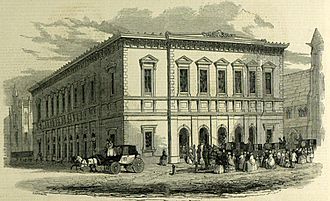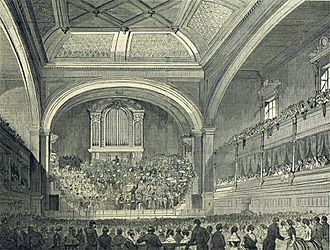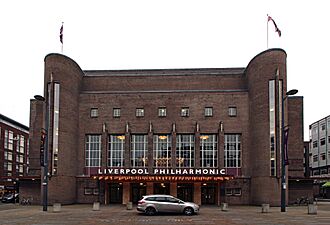Philharmonic Hall, Liverpool facts for kids

Exterior view of venue (c.2008)
|
|
| Address | Hope St Liverpool L1 9BP England |
|---|---|
| Location | Knowledge Quarter |
| Owner | Royal Liverpool Philharmonic Society |
| Capacity | 1,700 |
| Construction | |
| Broke ground | June 1937 |
| Opened | 19 June 1939 |
| Renovated |
|
| Construction cost | £120,000 (£5.55 million in 2021 sterling ) |
| Architect | Herbert Rowse |
| OS grid reference | SJ 356 898 |
| Architectural style(s) | Streamline Moderne |
|
Listed Building – Grade II*
|
|
| Reference no. | 1279652 |
The Liverpool Philharmonic Hall is a famous concert hall located on Hope Street in Liverpool, England. It is the home of the Royal Liverpool Philharmonic Society, a well-known music group. This building is very important, so it's listed as a Grade II* listed building on the National Heritage List for England. The hall you see today is not the first one. The original building was destroyed by a big fire in 1933. The current hall opened its doors in 1939.
Contents
The First Hall: A Musical Beginning
The Liverpool Philharmonic Society started in 1840. At first, they didn't have their own place for concerts. In 1844, they hired an architect named John Cunningham. He was asked to design a "concert room" for 1,500 people. It was planned to cost at least £4,000, which was a lot of money back then!
Later that year, they decided they needed an even bigger hall. It would hold 2,100 people and an orchestra of 250 musicians. There would also be rooms for refreshments and relaxing. People could buy shares in the hall and even purchase their own seats along the sides.
The first stone for the building was laid in 1846. There were plans for the famous composer Mendelssohn to write a special song for the opening. Sadly, Mendelssohn passed away before he could finish it.
The first hall cost £30,000 to build. It opened on August 27, 1849, with a week-long music festival. A reporter from The Times newspaper said it was "one of the finest and best adapted to music that I ever entered."
The reporter described the inside of the hall:
The orchestra, where the musicians played, was at one end of the hall. It was set back under an arch and filled with instruments and singers. There were many bronze music stands, each with a lyre on top. It looked very impressive. A large, simple organ was behind the orchestra. The main part of the hall was about 104 feet long, and with the orchestra, it was about 150 feet long. It was almost 100 feet wide. The room was shaped like a rectangle. There were 65 private boxes along each side, under the balconies. Above the balconies were bright gas lights. The main floor had comfortable seats, like armchairs, with plenty of space. There were three doors on each side for people to enter and leave. These were separated by windows with holes for air. Two huge arches on each side of the hall covered the boxes and balconies, making them look set back. Gilded pillars supported the balconies. At the opposite end from the orchestra, there were two more balconies, one above the other. The roof was covered with decorated plaster. The boxes were very fancy. During the day, four large windows lit the hall, two on each side.
Everyone agreed that the hall had amazing sound quality. A new organ was put in the hall in 1930. It cost £2,000.
The hall was the home of the Philharmonic Society until a fire started on July 5, 1933. More than 100 firefighters tried to put out the blaze. But the hall and the new organ were too badly damaged to be fixed. Over 10,000 people watched the fire from the streets. Luckily, no one was seriously hurt, as the hall was closed that day.
The next day, the head of the Philharmonic Society said the hall would definitely be rebuilt. He also said they would find another place to play until then. Some important items were saved from the fire. These included autograph books from 1848, signed pictures, and some instruments. They were kept safe in a fire-proof safe. However, the music library was lost. The building was insured, and the insurance company paid a lot of money to help rebuild. The exact cause of the fire was unknown, but it started in the roof. Work to clear the ruins began the very next day.
The Current Hall: A Modern Masterpiece
Building the New Hall
Building the new hall took some time. The city of Liverpool had specific demands. They wanted a building that could be used for both concerts and movies or plays. This caused some arguments, with famous conductor Sir Henry Wood speaking out against the city's idea. Eventually, they reached a compromise, and construction began in June 1937.
Herbert J. Rowse was chosen to design the new hall. He created a building in the Streamline Moderne style. This style is known for its smooth, curved shapes and modern look. The new hall included an organ built by a local company, Rushworth and Dreaper. The organ's console (where the organist plays) could even be lowered from the stage!
The hall officially opened on June 19, 1939. The very next day, a concert was held, conducted by Sir Thomas Beecham. The Manchester Guardian newspaper praised the new hall. They called it "magnificent" and said it was "ready to take its place among the most eminent homes of musical culture." The final cost of the hall was a little over £120,000. The architect was paid £6,869 for his design.
An extra part was added to the back of the hall in 1992. Then, in 1995, the hall had a big makeover that cost £10.3 million. During this work, the inside plaster was replaced with concrete. This was done to improve the sound quality. There is a special plaque inside the hall. It remembers the musicians of the RMS Titanic who died when the ship sank in 1912.
Another big renovation, costing about £14 million, finished in October 2015. This mainly updated the main concert hall. The 2015 renovation also added a new performance area called the Music Room. This new space can hold between 180 and 250 people. The Music Room officially opened to the public on October 9, 2015.
Hall Design and Features
The hall is built with light brown bricks and has three main levels. The front of the building is balanced, with a covered entrance. On each side of the entrance are round stair towers. Above the entrance are seven windows. These windows are separated by pillars with carved designs. Outside the hall, there are two separate pillars for displaying posters. Experts believe the hall's design was inspired by a Dutch architect named W. M. Dudok.
The windows above the entrance have glass with designs etched into them by Hector Whistler. Some glass door panels by Whistler, which show musical instruments in an art deco style, were shown on the BBC show Antiques Roadshow in 2015. A dealer from Liverpool had bought 13 of these panels in France. He wanted to donate some to local museums.
Inside the entrance, there is a copper memorial to the musicians of the Titanic. It was made by J. A. Hodel. On the landings, there are gilded (gold-covered) reliefs (sculptures that stick out from a flat surface) of Apollo. These were created by Edmund C. Thompson. The main concert area is "sensuously curved." On the walls, there are carved female figures in an art deco style. These figures represent different "musical moods" and were also made by Thompson.
The hall has a special 3-manual pipe organ built by Rushworth and Dreaper. Its console can be moved up onto the stage or down below it. There is also a Walturdaw rising cinema screen. This screen often comes up with music played by the hall's organist.
What Happens at the Hall Today?
The Liverpool Philharmonic Hall hosts over 250 events every year. More than 60 of these are classical music concerts. The main hall can hold 1,700 people. Smaller events take place in the Music Room, Green Room, and 1840 Room.
Other shows include all kinds of music, from international stars like Sir Cliff Richard and Bryan Ferry to Kraftwerk. Comedians also perform here, and films are shown on the Walturdaw screen. You can take tours of the hall to learn more about it. The hall can also be rented for special events, like weddings or company gatherings.
|




